 Forrest Gump was, and still is for that matter, unlike any movie that has ever been released. Tom Hanks brought Forrest Gump to life and we followed his story from boyhood to manhood. But this movie is more then the story of a man's life. This is an American story. It encompasses the most memorable aspects of the later half of the 20th century. Cleverly, the film breathes life into history. Gump teaches Elvis to dance, inspires Lennon to write "Imagine," breaks Watergate open, becomes a hero in the Vietnam War and an inspiration to the nation.
Forrest Gump was, and still is for that matter, unlike any movie that has ever been released. Tom Hanks brought Forrest Gump to life and we followed his story from boyhood to manhood. But this movie is more then the story of a man's life. This is an American story. It encompasses the most memorable aspects of the later half of the 20th century. Cleverly, the film breathes life into history. Gump teaches Elvis to dance, inspires Lennon to write "Imagine," breaks Watergate open, becomes a hero in the Vietnam War and an inspiration to the nation.What I really like about this film is how is says so much, but at the same time leaves the viewer to think. There certainly is a lot to think about with this movie and it is up to the viewer to connect with the film. First of all, there is the feather that drifts in at the beginning of the movie and flies out at the end. There have been several theories as to what the feather represents. I feel that the feather represents man's individual journey. It floats around alone, much like man in his journey. The feather might land in a situation where there is greatness, or it may fall somewhere undesirable. In the case of Forrest Gump it falls in the hands of someone who takes care of it and cherishes it. It is much like the life that Gump lives. He floats about aimlessly on his own. During his journey he falls into the hand of both those who treat him with car, and those who do not. Likewise, Jenny (Robin Wright) floats about aimlessly and wild. Even more like at a feather at the hands of fate. While Gump floats through life hitting moments of greatness, Jenny floats through life on a complete polar opposite. Gump affects and is involved in mainstream America, but Jenny is consumed in counter cultures and the underground of America. From sexual abuse, to drugs, life threatening disease and single parenthood, her storyline gives a completely opposite version of American life in the 20th century. It makes the movie even more amazing in the amount of topics it covers.
Through the film there are several other key characters. Bubba (Mykelti Williamson) takes Gump on as a friend when he is headed to Vietnam. Bubba also guides Gump in the direction to become a multi-millionaire after the war by entering the shrimping industry. Lt. Dan Taylor (Gary Sinise) is Gumps commander in the war, whose life Gump saves and brings another aspect of American history to the film when he comes back from the war and is essentially thrown away for what he has done. Gump saves his life once again as the film progresses and he offers Lt. Dan a position in the shipping industry. Of course no character is more touching then that of Forrest's Mother (Sally Field). Field is amazing in this role and it suits her so perfectly. She is an absolute delight in every appearance she makes on the screen. And although briefly in the film, Haley Joel Osment appears as Forrest Gump Jr.
This is one of those films that is expected to be on the list of films to see, and if it wasn't, it would be a disgrace. I can remember seeing this film in the theater. It was one of those films that was so epic and touching. The sight of the historical footage mended into the film made it amazing, and I can still remember walking out of the theater, my head in a daze for hours trying to completely grasp everything I saw. Powerful, beautiful and perfect in every way.

















